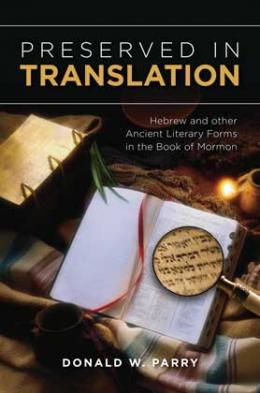
Review
======
Title: Preserved in Translation: Hebrew and Other Ancient Literary Forms in the Book of Mormon
Author: Donald W. Parry
Publisher: Deseret Book and RSC BYU
Genre: Religious Non-fiction
Year Published: 2020
Number of Pages: 171
Binding: Hardcover
ISBN10: 2019058169
ISBN13: 9781944394950
Price: $19.99
Reviewed by Michelle Magnusson for the Association for Mormon Letters
Good was the book, and the book was good. Preserved in Translation: Hebrew and Other Ancient Literary Forms in the Book of Mormon is an enjoyable read straight through, but it is also organized to be an easy reference tool. Author Donald W. Parry makes a solid case for the benefits of exploring Hebrew literary devices more deeply, not just as a scholastic exercise, but in an effort to better feast upon the scriptures and gain deeper meaning from their words. He offers well-rendered, clear examples of Hebraisms in the Book of Mormon that both clarify the principle being taught and edify the reader.
Some structures that he writes about—such as chiasmus, repetition, and specific symbols—will be familiar to readers who have utilized Latter-day Saint curricula in the past, but Parry brings a new depth even to these familiar Hebraisms. Additionally, Preserved in Translation explores plenty of less-familiar avenues as well. Parry organizes the literary forms discussed in Preserved into four categories: parallelisms and poetic structures, the art of repetition, prophetic actions and language, and other Hebraic patterns. The parallelisms and poetic structures section explores chiasmus; climactic expressions; synonymous, antithetical, coordinating, extended, and number parallelism; and word pairs. The art of repetition chapters expand on theme words, refrain, resumptive repetition, possessive pronouns, and the repetition of “the” and “and” as meaningful. The third section explores how prophets use symbolic action as a prophetic curse, the prophetic perfect tense, simile curses, inverted quotations, and prophetic speech forms. Other Hebraic patterns addressed include idea-amplifying plurals, the expression “and it came to pass”, cognate verbs and objects, noun phrases using “of”, adverbial phrases using “with”, “and” as a disjunctive marker, delayed subjects, emphatic first-person pronouns, conditional clauses, the witness of ancient inscriptions, and wordplays.
If this list sounds too linguistic for you, do not be afraid. Parry addresses each clearly and simply with examples that illuminate each form while giving you the academic terms to make you sound like an expert in Gospel Doctrine class. There are enough examples of each element for the reader to feel confident identifying others independently, but not so many as to overwhelm the casual reader or belabor the point. Examples are presented first from the Old Testament and then in the Book of Mormon for comparison.
Each short section identifies the Hebraism and simple meaning but also clarifies the deeper purpose or reason each device might have been used. Parry emphasizes how writers of scripture select particular literary devices to emphasize various key points. This enriches personal scripture study by introducing potential new interpretations of familiar scriptures and illuminating some difficult passages that use language or symbols unfamiliar to the modern reader.
Parry provides a succinct but rich review of the academic literature in a way that is accessible to non-scholars. Throughout the book, sidebar “Scholar Spotlights” highlight individual experts in the field, past and present. Excellent chapter endnotes allow the reader to dig deeper into specific academic or devotional topics of interest. Additional callouts provide a deeper analysis of particular principles, provide photographs and illustrations, or compare English and Hebrew text. Clean tables offer a quick reference for lists of symbols; I found myself wishing for more tables for future quick reference during scripture study.
Of particular interest was the discussion of Hebraisms present in the original Book of Mormon manuscript but removed in later editions to provide a better idiomatic English translation. Keen to engage others, Parry highlights a few areas where additional analysis and study would be warranted by scholars.
To round out the book, there is an extensive works cited and a useful index with a good mix of symbols, authors, and scriptural names or phrases. An index organized by scripture to allow for easy reference when studying specific chapters or verses would strengthen the book as a reference tool.
This isn’t just a book about linguistics. Parry comments on more than just poetic literary devices or clever wordplay. He also focuses on how these truly are tools to better understand the scriptures and those who recorded them. Preserved in Translation: Hebrew and Other Ancient Literary Forms in the Book of Mormon is a great tool for gleaning more from your scriptural feast.
